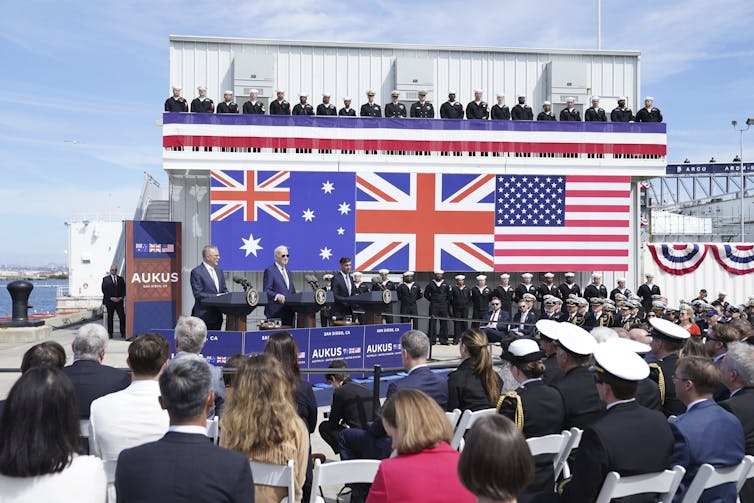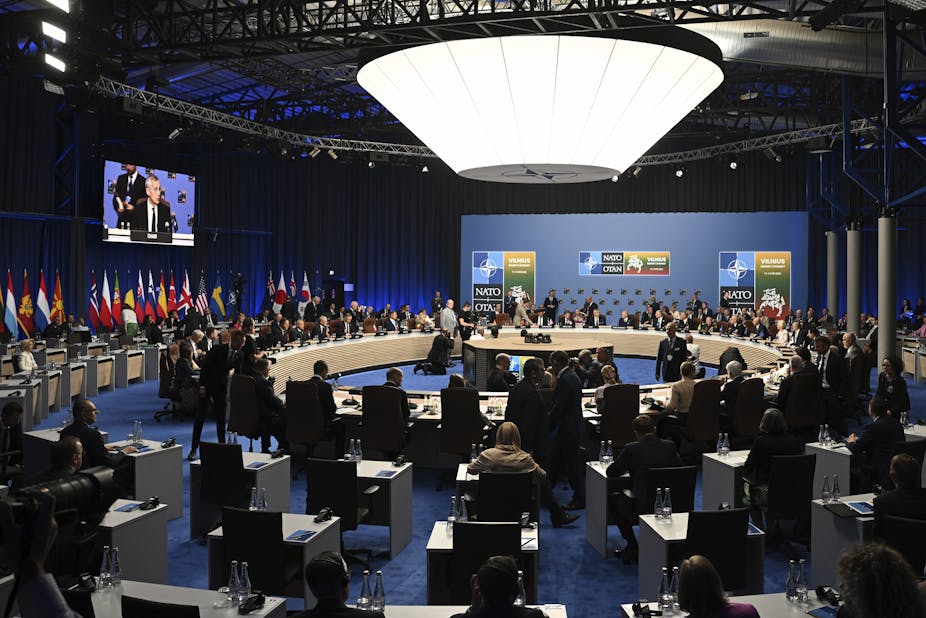After the recent NATO summit in Vilnius, Lithuania, it is anticipated that Sweden will soon become the alliance’s 32nd member.
The heart of this alliance – which was established in the aftermath of World War II to promote the collective security of its mostly Western European members – is Article 5 of the North Atlantic Treaty, which requires that if one member is attacked, then all of the other members will respond as if they themselves had been attacked.
Its most recent addition came in April 2023, when Finland became the 31st country to join.
At present, NATO currently recognizes Bosnia and Herzegovina, Georgia, and Ukraine as aspiring members.
But NATO isn’t the only alliance that countries across the globe are eager to join.
For more than 75 years, Australia, Canada, New Zealand, the U.K. and the U.S. have been sharing intelligence with one another as part of what they call the Five Eyes alliance.
I am a former U.S. Army intelligence analyst who now studies and teaches political science. I know from personal experience that the Five Eyes is still very active in the 21st century, even though it’s not as well known as its younger sibling NATO.
Origins

In 1940, during the prime ministership of Winston Churchill, a secret effort by U.K. codebreakers to deconstruct Germany’s Enigma machine succeeded, allowing the British to read German military messages. These messages ended up being a major source of intelligence throughout World War II, providing much-needed information about German troop numbers, military maneuvers and technological developments.
British mathematician Alan Turing is probably the most widely recognized person who worked to help crack the Enigma machine. But in reality it was the collective effort of hundreds of men and women, including mathematicians, linguists and even chess champions.
Parallel to these developments, U.S. codebreakers were able to successfully crack diplomatic codes used by the Japanese.
In February 1941, an American military delegation was invited to visit the U.K. codebreaking operation, based on an estate called Bletchley Park. However, when “approving the visit, Churchill … prohibited any British discussion of their success against the Enigma” machine, according to a 2016 speech by Richard Ledgett, then the deputy director of the U.S. National Security Agency.
Upon their arrival, the American officers “explained how to break the Japanese codes,” Ledgett said, going on to observe that the information “caused the British to re-examine their initial decision” to keep their Enigma success a secret.
Afterward, Churchill approved a request to reveal “to our American colleagues the progress … made in probing German Armed Force cryptography.”
Throughout the remainder of the war, the U.K. and U.S. continued working together to enhance their codebreaking capabilities. In 1943, this informal relationship was formalized with the Britain-United States of America, or BRUSA, agreement.
This intelligence alliance was further strengthened by the UKUSA agreement signed on March 5, 1946. That same day, Churchill was at Westminster College in Fulton, Missouri – the college where I now teach – giving his “Iron Curtain” speech.
In 2010, this top-secret agreement was declassified and made publicly available for the first time.
Canada joined the UKUSA agreement in 1948. Australia and New Zealand joined in 1956. Thus, the the Five Eyes was born.
Recent developments
To address the rising power of China, members of the Five Eyes have recently expanded the scope of the alliance beyond intelligence sharing into the realm of policy. Five Eyes attorneys general now regularly meet, as do finance and defense ministers.
In November 2020, the once-secretive Five Eyes alliance took the bold step of publicly issuing a joint statement condemning China’s National Security Law for “undermin[ing] Hong Kong’s high degree of autonomy.”
China responded by warning that “attempts by certain countries to meddle in Hong Kong politics … are futile and doomed to fail.”
Notably, China is New Zealand’s largest export market. At the time, New Zealand was also hoping to conclude an upgraded free trade deal with China.
In January 2021, the Five Eyes countries – except New Zealand – issued a joint statement condemning “the mass arrests of 55 politicians and activists in Hong Kong for subversion under the National Security Law.” That same month, China and New Zealand signed the upgraded free trade deal.
Since that time, New Zealand has continued to avoid taking as strong a position as the rest of the Five Eyes. As a result, the U.S. has sought to circumvent New Zealand’s reluctance by formalizing other agreements without the Kiwis.
For example, in September 2021, Australia, the U.K. and the U.S. announced the AUKUS partnership. Under this agreement, the three countries “will expand and accelerate [the] sharing of sensitive information.” Canada has expressed a desire to join the AUKUS partnership. This would leave New Zealand as the only Five Eyes member outside of the pact.
The Five Eyes alliance has had to deal with other internal difficulties as well. For example, the U.S. has had several notable intelligence failures, including the leaks of classified documents by Edward Snowden and former President Donald Trump’s alleged hoarding of classified documents. Both of those events undermine U.S. assurances to its allies that it can keep a secret.

Looking ahead
Over the years, several countries have been considered as potential candidates to join the Five Eyes, including India, Israel, Germany and South Korea.
Currently, the most likely candidate is probably Japan. At the end of 2016, Australia and the U.S. signed a trilateral agreement with Japan to deepen their covert security cooperation. As of 2020, Japan’s minister of defense was enthusiastically in favor of joining the Five Eyes. In 2021, Japan’s ambassador to Australia argued that “in terms of interests and capability, Japan is the best candidate” to consider for enlarging the Five Eyes.
In 2022, the U.S. House Subcommittee on Intelligence and Special Operations “acknowledge[d] that the threat landscape has vastly changed since the inception of the Five Eyes arrangement, with primary threats now emanating from China and Russia.” It recommended “expanding the Five Eyes arrangement to include … Japan.”
Regardless of whether Japan – or others – ends up joining the alliance, a Chinese foreign ministry spokesman warned in 2020 that “no matter how many eyes they have, five or 10 or whatever, should anyone dare to undermine China’s sovereignty, security and development interests,” they should “be careful not to get poked in the eye.”

